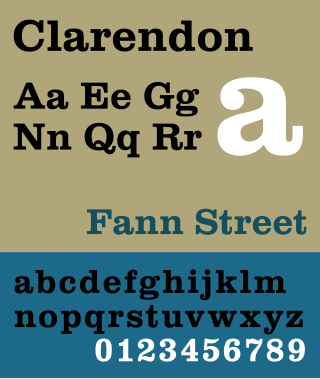
Helvetica, also known by its original name Neue Haas Grotesk, is a widely used sans-serif typeface developed in 1957 by Swiss typeface designer Max Miedinger and Eduard Hoffmann.

Futura is a geometric sans-serif typeface designed by Paul Renner and released in 1927. It was designed as a contribution on the New Frankfurt-project. It is based on geometric shapes, especially the circle, similar in spirit to the Bauhaus design style of the period. It was developed as a typeface by the Bauer Type Foundry, in competition with Ludwig & Mayer's seminal Erbar typeface of 1926.
Raymond Larabie is a Canadian designer of TrueType and OpenType computer fonts. He owns Typodermic Fonts, which distributes both commercially licensed and shareware/freeware fonts.

Eras is a humanist sans-serif typeface designed by Albert Boton and Albert Hollenstein and was released by the International Typeface Corporation (ITC) in 1976. Eras is licensed by the Linotype type foundry.

Franklin Gothic and its related faces are a large family of sans-serif typefaces in the industrial or grotesque style developed in the early years of the 20th century by the type foundry American Type Founders (ATF) and credited to its head designer Morris Fuller Benton. "Gothic" was a contemporary term meaning sans-serif.
Aldo Novarese was an Italian type designer who lived and worked mostly in Turin.

Cooper Black is an ultra-bold serif typeface intended for display use that was designed by Oswald Bruce Cooper and released by the Barnhart Brothers & Spindler type foundry in 1922. The typeface was drawn as an extra-bold weight of Cooper's "Cooper Old Style" family. It rapidly became a standard typeface and was licensed by American Type Founders and also copied by many other manufacturers of printing systems.

Eurostile is a geometric sans-serif typeface designed by Aldo Novarese in 1962. Novarese created Eurostile for one of the best-known Italian foundries, Nebiolo, in Turin.

Clarendon is the name of a slab serif typeface that was released in 1845 by Thorowgood and Co. of London, a letter foundry often known as the Fann Street Foundry. The original Clarendon design is credited to Robert Besley, a partner in the foundry, and was originally engraved by punchcutter Benjamin Fox, who may also have contributed to its design. Many copies, adaptations and revivals have been released, becoming almost an entire genre of type design.

Rotis is a typeface developed in 1988 by Otl Aicher, a German graphic designer and typographer. In Rotis, Aicher explores an attempt at maximum legibility through a highly unified yet varied typeface family that ranges from full serif, glyphic, and sans-serif. The four basic Rotis variants are:

News Gothic is a sans-serif typeface designed by Morris Fuller Benton, and was released in 1908 by his employer American Type Founders (ATF). The typeface is similar in proportion and structure to Franklin Gothic, also designed by Benton, but lighter.

ITC Avant Garde Gothic is a geometric sans serif font family based on the logo font used in the Avant Garde magazine. Herb Lubalin devised the logo concept and its companion headline typeface, and then he and Tom Carnase, a partner in Lubalin's design firm, worked together to transform the idea into a full-fledged typeface.

Stencil refers to two typefaces released within months of each other in 1937. The face created by R. Hunter Middleton for Ludlow was advertised in June, while Gerry Powell's version for American Type Founders appeared one month later. Both fonts consist of only capital letters with rounded edges and thick main strokes, much like a Clarendon typeface, except with breaks in the face to give it the appearance of the stenciled alphabets used on boxes and crates. Powell's exploration of Stencil became very popular over time and is still used today.

Handel Gothic is a geometric sans-serif typeface designed in 1965 by Donald J. Handel (1936–2002), who worked for the graphic designer Saul Bass.

The Bauhaus typeface design is based on Herbert Bayer's 1925 experimental Universal typeface and the Bauhaus aesthetic overall.
Neo Sans and Neo Tech are the typefaces designed by the British type designer Sebastian "Seb" Lester. The typefaces were released by Monotype Corporation on April 19, 2004. The design concept called for a versatile, futuristic typeface that didn't look "crude, gimmicky or ephemeral".

Ubuntu is an OpenType-based font family, designed to be a modern, humanist-style typeface by London-based type foundry Dalton Maag, with funding by Canonical Ltd. The font was under development for nearly nine months, with only a limited initial release through a beta program, until September 2010. It was then that it became the new default font of the Ubuntu operating system in Ubuntu 10.10. Its designers include Vincent Connare, creator of the Comic Sans and Trebuchet MS fonts.
The Fonderia Nebiolo was a manufacturer of printing presses and paper and formerly a type foundry. Nebiolo & Co. was created in 1878 when Giovanni Nebiolo bought out the type foundry of G. Narizzano in Turin, Italy, in 1852. In 1908 the company merged with the Urania Company and operated under the name Augustea and began to buy out many smaller foundries. In 1916 it was again renamed Società Nebiolo. In 1976 in occasion of the renovation of the Company that naturally would have come to an end that year, Fiat entered into the press manufacturing business and the Studio Artistico was closed up. In 1992 it became Nebiolo Printech S.p.A. and continues to manufacture presses under that name today.

Semplicità is a sans-serif typeface of the geometric style. It was published by the Nebiolo type foundry of Turin, Italy from around 1928.















